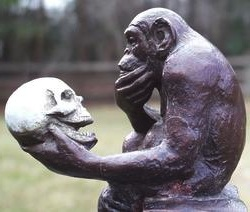Empathy
The Evolutionary Origins of Empathy
How one ape species became emotionally modern humans.
Posted December 23, 2016
It is even harder for the average ape to believe that he descended from man. - H. L. Mencken

With the daily news of violence in the media, it’s useful to remember that humans are cooperative apes, more so than chimpanzees and other primates, writes anthropologist and evolutionary psychologist Sarah Blaffer Hrdy. Hrdy is an influential primatologist devoted to the scientific study of primates (the mammals that include humans), both alive and extinct.
Our inclination for working together emerged in the childrearing practices of our ape ancestors who lived a few million years ago. Hrdy argues that this kind of human cooperation — the shared childcare of these apes — was the turning point that led to us as emotionally modern human beings, capable of mutual recognition and understanding.
Hrdy defines two major kinds of primate caretaking ever since the Pleistocene epoch or "Ice Age." Cooperative childcare or what she calls “cooperative breeding” characteristic of certain African hunter-gatherers and the exclusive care of all other apes (rearing by only one caregiver). A maternal ape who practices exclusive care has more distrust of her environment, group members, and is reluctant to allow anyone else hold her infant or help care for it. This inclination prevails today in other primates not directly related to human ancestry. Hrdy describes these non-human apes: these mothers “in the wild are obsessively anxious about their babies” and legitimately so because infanticide by male and female chimpanzees and gorillas is a leading cause of infant mortality.
Yet cooperative breeding in a certain line of homo sapiens contributed to the protection of infants and a higher survival rate. What was useful to species' survival led to the selection of these traits and they were passed to future generations. Among our human ancestors a vital resource became cooperation and the goodwill of others, reliable in times of food shortage, predatory threat or severe climate. Shared care meant an expanded network of caregivers and including those other than biological parents. Our ape ancestors came to appreciate these sharing partners, also called "alloparenting."
"Allo" comes from the Greek meaning "other than," denoting any person other than biological parents who help with childrearing. Therefore infants of our ancestral tribes were securely embedded in a spectrum of trusting personal relationships with not only mother, but fathers, siblings, grandparents – but also those unrelated biologically or of “fictive kin.” It took a village to raise the young among the Pleistocene foragers.
Cooperative childcare was a decisive point in human evolution, Hrdy claims. This routine of shared care made certain apes “emotionally modern” in comparison to other apes such as chimpanzees. It gave them a new way of understanding others. Specifically, it led to an enhanced ability to share sates of mind, giving human apes an aptitude for "mind-reading," the ability to imagine and identify with many others. The apes on the African savannah became curious about intersubjectivity: the subjective lives – the thoughts and feelings – of caregiving others. Hrdy's research supports the idea that babies grow emotionally through their relationship to mothers and multiple others, which then in term impacts our biology.
As Neurophysiologist Giacomo Rizzolatti at the University of Parma discovered in 1996 when he placed electrodes in the frontal cortex of the macaque monkey, a neuron fires when an animal observes an action performed by another, "mirroring" the behavior as though the onlooking monkey was itself doing the action. This kind of brain mimicry plays a role in the experience of empathetic feeling.
American poet and naturalist Diane Ackerman describes it this way: “As the most social apes, we inhabit a mirror-world in which every important relationship, whether with spouse, friend or child, shapes the brain, which in turn shapes our relationships.”

The cooperative care hypothesis proposed by Hrdy complicates attachment theory, which is a psychological model of early development that emphasizes an infant’s need to develop a relationship with one principal caregiver. Hrdy states that John Bowlby, a pioneer in attachment and child development in the late 1950s, overlooked many modes of infant care among primates. The discipline of primatology was new at the time of his research and since then many other infant-sharing species have been studied. “The continuous contact between mother and infant that seemed so self-evident and so natural to Bowlby, as well as to Darwin…leaves out the other 40-50 percent of some 276 species…Mothers in these species freely allow other group members to hold their babies ” (84).
Hrdy also points out that conclusions drawn by Bowlby were influenced by a cultural bias in his research. The species Bowlby studied – gorillas, chimpanzees, baboons and rhesus macaques — ignored collectivist primate cultures and “conformed to preconceived Western ideals of how a mother should care for her infant.” Subsequent research shows modes of attachment are less fixed and social development is significantly impacted by later relationships, in addition to the earliest ones.
"I view my fellow man not as a fallen angel, but as a risen ape," writes zoologist and surrealist painter Desmond Morris. Despite the onslaught of destruction in our morning headlines this holiday season bear in mind Hrdy’s suggestion that even our ape ancestors were capable of trust and mutual understanding. These ancient relatives of modern man had the edge over other animal species because of their predisposition for raised consciousness.
It began in mystery and it will end in mystery, but what a savage and beautiful country lies in between. — Diane Ackerman
Follow me: www.twitter.com/mollycastelloe
References
Hrdy, Sarah Blaffer. (2011) Mothers and Others: the evolutionary origins of mutual understanding. Cambridge, MA: Harvard, U P.




